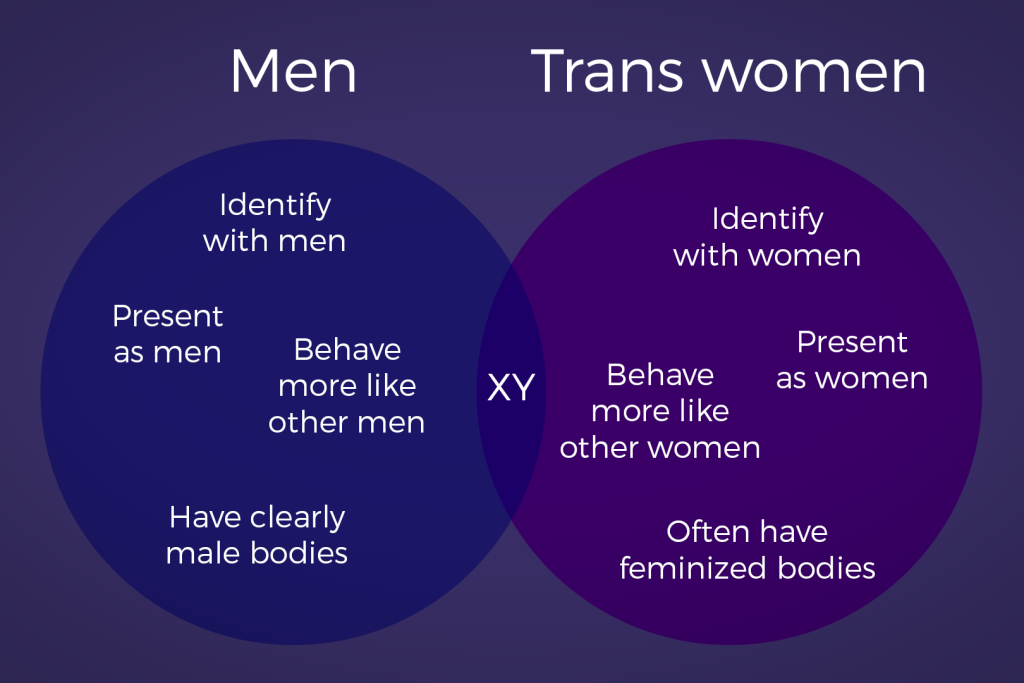(Support Gender Analysis on Patreon!)
Previously: Bathroom bills: dehumanization and control, Stop calling trans women “male”
There’s a popular belief that XX or XY chromosomes should serve as the sole determinant of whether someone is a woman or a man. This is a model of sex assignment that’s easy and absolute, offering two clearly divided categories that are meant to encompass everyone. This definition even appeared as part of legislation filed in Texas this year, which stated:
A male is an individual with at least one X chromosome and at least one Y chromosome, and a female is an individual with at least one X chromosome and no Y chromosomes.
In this instance, the binary chromosomal model was used to target transgender people using public facilities, attempting to force trans women to use men’s restrooms and trans men to use women’s restrooms. Similarly, this definition of individual sex commonly serves to force trans women and trans men into categories that contradict who they are, regarding trans women as “really men” and trans men as “really women”. This definition proves inadequate in many circumstances, and neglects to consider many important aspects of trans people’s lives. XX and XY aren’t the whole story here.
Where a model of gender breaks down
It’s important to remember that this is a question of definitions, not facts. Nobody is challenging the fact that most trans women do have XY chromosomes and most trans men have XX chromosomes. This is about the construction of a definition, and which aspects of reality should connect to the words “woman” and “man”.
So why might someone prefer the binary chromosomal model of sex? What makes it stand out? One reason this definition holds such widespread appeal is that it treats a person’s sex as fixed and forever unchanging. It differs from concepts of gender based on mutable features such as self-identification, public presentation, legal designation, medical diagnosis, or genital anatomy. Unlike these, it forecloses any possibility of transit between categories, and serves to invalidate the genders of trans people in a final sense. It’s a model that seems to eradicate any hint of nuance, but it does so by simply refusing to acknowledge it.
Trans people are an edge case of this model. We are a specific and well-known instance where the one-to-one mappings of XX to women and XY to men no longer allow you to make accurate inferences about a person. Men tend to identify themselves as belonging to the general social group known as men, present in a way that allows them to be recognized as men, behave in ways that are more similar to other men than to women, and have an unambiguously male physiology. Trans women generally don’t exhibit these features, yet the binary chromosomal definition groups them together with men based solely on their chromosomes.

If “man” is equated to “XY”, then all that the word “man” will tell you is that someone has XY chromosomes – nothing more.

It loses a great deal of its value as a useful and informative term for a real phenomenon, because it disregards and even contradicts the other meanings associated with the word “man” in common usage.
Defining gender around transphobia
Those who insist on the binary chromosomal definition gloss over all the significant details of trans people’s lives and experiences in their haste to label trans women as “men” and trans men as “women”. But trans people aren’t the only edge case of this model. In certain intersex conditions such as Swyer syndrome and complete androgen insensitivity syndrome (CAIS), a woman develops typically female physical features while nevertheless having XY chromosomes. These women most frequently identify and live as women, and are almost universally acknowledged as women.
Notably, they are not the intended targets of legislation in several states that would make it a crime to use a public restroom without possessing the proper chromosomes. They’re not the ones being described as “a man who feels like he is a woman” by a Texas state representative who authored such legislation. In this case, the binary chromosomal model is generally suspended in practice and certain women with XY chromosomes are simply treated as women. Even though women with these intersex conditions are estimated to be 10 to 100 times less common than trans women, a de facto exception is made for this very small edge case and not for a much larger one.

So what purpose does this model of sex serve? Is this definition endorsed by those who are interested in most accurately capturing the prevailing usage of the terms “woman” and “man”? No – it ignores almost every feature related to sex except one. Are they genuinely that fixated on chromosomes alone, with their classification of trans women as “men” just happening to follow from that? No – intersex people are almost never the focus of these arguments. Could it be that this model is crafted specifically to invalidate and misgender trans people? It certainly seems like it.
This year’s streak of bathroom legislation comes as a time when public interest in transgender subjects is perhaps greater than ever. Did the proponents of this oversimplified model just coincidentally get the idea to codify it in law all at the same time, for no apparent reason? It’s not as if this came on the heels of a Time magazine cover story about “the Swyer syndrome tipping point”. There’s no widespread anxiety over women with androgen insensitivity in women’s restrooms. It’s clear that the driving principle behind this chromosome-based model isn’t actually a single-minded obsession with chromosomes. This just happens to be the most convenient choice for erasing trans people’s genders. Ultimately, this definition attempts to hijack the concept of gender itself and wield it as an instrument of transphobia.
Gender definitions don’t imply trans priorities
In discussions of trans people’s placement within competing systems of gender, one aspect is often left unaddressed: the practical relevance of these definitions to trans people’s everyday lives. Cis people can easily slip into treating us as an abstract philosophical puzzle to be debated over, with sweeping pronouncements about how a trans woman can’t possibly be a “real woman” without XX chromosomes. It seems far less common for them to stop and question whether this actually matters to us at all.
There’s no particular reason why a given model of what makes someone a “woman” or “man” would have any connection to how trans people go about living as our genders. The International Astronomical Union was debating how best to classify Pluto while the New Horizons probe was already on its way. But mission control didn’t have to monitor every new resolution and make course corrections based on whichever draft proposal had the most support at the time. Regardless of whether Pluto is defined as a planet, a dwarf planet, or anything else, Pluto is still Pluto. Its mass, orbit, and other features don’t change based on how we classify it. Similarly, our lives as trans people are quite separate from how we’re labeled.
For the most part, we have very little reason to care about chromosomes. What would a change of sex chromosomes offer us? Gene therapy is still a highly experimental field, and can cause serious immune reactions and even cancer. There’s currently no way to remove a whole chromosome from a living person’s cells and replace it with an entirely different one. Even if this were possible and safe, there’s no reason to think it would have any useful effect beyond what hormone therapy and surgeries already offer. These are safe and mature technologies that are known to be medically effective for the treatment of gender dysphoria – something that actually does matter to trans people.
From our perspective, based on our experiences and our needs, this emphasis on sex chromosomes is entirely misplaced. There are so many factors that are far more relevant to my life as a trans woman than the specifics of which chromosomes I’m carrying around. You know what’s easier than changing our chromosomes? Changing your mind. ■




Pingback: Everything is pretty great* (Gender Analysis 15) | Gender Analysis
Pingback: Book review: “Becoming Nicole” by Amy Ellis Nutt (Gender Analysis) | Gender Analysis
Pingback: Gender Analysis: Zinnia Argues With People | Gender Analysis
Pingback: Fractals, not pyramids: Why “8th grade biology” isn’t enough | Gender Analysis
Pingback: Medical professionals increasingly agree: Trans women are female, trans men are male | Gender Analysis